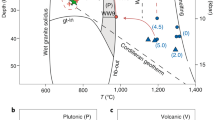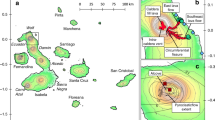Abstract
Segregation of magma from the mantle in subduction zones is one of the principal mechanisms for chemical differentiation of the Earth. Fundamental aspects of this system, in particular the processes by which melt forms and travels to the Earth’s surface, remain obscure. Systematics in the location of volcanic arcs, the surface expression of this melting, are widely considered to be a clue to processes taking place at depth, but many mutually incompatible interpretations of this clue exist (for example, see refs 1–6). We discriminate between those interpretations by the use of a simple scaling argument derived from a realistic mathematical model of heat transfer in subduction zones. The locations of the arcs cannot be explained by the release of fluids in reactions taking place near the top of the slab. Instead, the sharpness of the volcanic fronts, together with the systematics of their locations, requires that arcs must be located above the place where the boundary defined by the anhydrous solidus makes its closest approach to the trench. We show that heat carried by magma rising from this region is sufficient to modify the thermal structure of the wedge and determine the pathway through which both wet and dry melts reach the surface.
This is a preview of subscription content, access via your institution
Access options
Subscribe to this journal
Receive 51 print issues and online access
$199.00 per year
only $3.90 per issue
Buy this article
- Purchase on Springer Link
- Instant access to full article PDF
Prices may be subject to local taxes which are calculated during checkout




Similar content being viewed by others
References
Gill, J. Orogenic Andesites and Plate Tectonics (Springer, 1981)
Kushiro, I. in Magmatic Processes: Physicochemical Principles (ed. Mysen, B.) Vol. 1, 165–181 (Geochemical Society Special Publication, 1987)
Tatsumi, Y. & Eggins, S. Subduction Zone Magmatism (Blackwell Science, 1995)
Schmidt, M. & Poli, S. Experimentally based water budgets for dehydrating slabs and consequences for arc magma generation. Earth Planet. Sci. Lett. 163, 361–379 (1998)
Tatsumi, Y. The subduction factory: how it operates in the evolving Earth. GSA Today 15, 4–10 (2005)
Grove, T. L., Till, C. B., Lev, E., Chatterjee, N. & Médard, E. Kinematic variables and water transport control the formation and location of arc volcanoes. Nature 459, 694–697 (2009)
Tovish, A. & Schubert, G. Island arc curvature, velocity of convergence and angle of subduction. Geophys. Res. Lett. 5, 329–332 (1978)
England, P. C., Engdahl, E. R. & Thatcher, W. Systematic variation in the depths of slabs beneath arc volcanoes. Geophys. J. Int. 156, 377–408 (2004)
Ulmer, P. & Trommsdorff, V. Serpentine stability to mantle depths and subduction-related magmatism. Science 268, 858–861 (1995)
van Keken, P. et al. A community benchmark for subduction zone modeling. Phys. Earth Planet. Inter. 171, 187–197 (2008)
England, P. & Wilkins, C. A simple analytical approximation to the temperature structure in subduction zones. Geophys. J. Int. 159, 1138–1154 (2004)
Engdahl, E., van der Hilst, R. & Buland, R. Global teleseismic earthquake relocation with improved travel times and procedures for depth determination. Bull. Seismol. Soc. Am. 88, 722–743 (1998)
Syracuse, E. M. & Abers, G. A. Global compilation of variations in slab depth beneath arc volcanoes and implications. Geochem. Geophys. Geosyst. 7 (5), Q05017 10.1029/2005GC001045 (2006)
England, P. C. & Katz, R. F. Global systematics of arc volcano position. Nature 10.1038/nature09154 (in the press)
Katz, R., Spiegelman, M. & Langmuir, C. A new parameterization of hydrous mantle melting. Geochem. Geophys. Geosyst. 4 (9), 1073 10.1029/2002GC000433 (2003)
Kelley, K. A. et al. Mantle melting as a function of water content beneath back-arc basins. J. Geophys. Res. 111 B09208 10.1029/2005JB003732 (2006)
Baker, M., Grove, T. & Price, R. Primitive basalts and andesites from the Mt. Shasta region, N. California—products of varying melt fraction and water content. Contrib. Mineral. Petrol. 118, 111–129 (1994)
Sisson, T. & Bronto, S. Evidence for pressure-release melting beneath magmatic arcs from basalt at Galunggung, Indonesia. Nature 391, 883–886 (1998)
Elkins-Tanton, L., Grove, T. & Donnelly-Nolan, J. Hot, shallow mantle melting under the Cascades volcanic arc. Geology 29, 631–634 (2001)
Cameron, B. et al. Flux versus decompression melting at stratovolcanoes in southeastern Guatemala. J. Volcanol. Geotherm. Res. 119, 21–50 (2003)
Tatsumi, Y. & Suzuki, T. Tholeiitic vs calc-alkalic differentiation and evolution of arc crust: constraints from melting experiments on a basalt from the Izu-Bonin-Mariana arc. J. Petrol. 50, 1575–1603 (2009)
Conder, J., Wiens, D. & Morris, J. On the decompression melting structure at volcanic arcs and back-arc spreading centers. Geophys. Res. Lett. 29 1727 10.1029/2002GL015390 (2002)
Cagnioncle, A.-M., Parmentier, E. M. & Elkins-Tanton, L. T. Effect of solid flow above a subducting slab on water distribution and melting at convergent plate boundaries. J. Geophys. Res. 112 B09402 10.1029/2007JB004934 (2007)
Sparks, D. & Parmentier, E. Melt extraction from the mantle beneath spreading centers. Earth Planet. Sci. Lett. 105, 368–377 (1991)
Spiegelman, M. Physics of melt extraction: theory, implications, and applications. Phil. Trans. R. Soc. Lond. A 342, 23–41 (1993)
Hirschmann, M. M., Asimow, P. D., Ghiorso, M. S. & Stolper, E. M. Calculation of peridotite partial melting from thermodynamic models of minerals and melts. III. Controls on isobaric melt production and the effect of water on melt production. J. Petrol. 40, 831–851 (1999)
Crisp, J. Rates of magma emplacement and volcanic output. J. Volcanol. Geotherm. Res. 20, 177–211 (1984)
Reymer, A. & Schubert, G. Phanerozoic addition rates to the continental crust and crustal growth. Tectonics 3, 63–77 (1984)
Dimalanta, C., Taira, A., Yumul, G., Tokuyama, H. & Mochizuki, K. New rates of western Pacific island arc magmatism from seismic and gravity data. Earth Planet. Sci. Lett. 202, 105–115 (2002)
White, S., Crisp, J. & Spera, F. Long-term volumetric eruption rates and magma budgets. Geochem. Geophys. Geosyst. 7, Q03010 (2006)
Katz, R. Magma dynamics with the enthalpy method: benchmark solutions and magmatic focusing at mid-ocean ridges. J. Petrol. 49 10.1093/petrology/egn058 (2008)
Knepley, M., Katz, R. & Smith, B. in Numerical Solution of Partial Differential Equations on Parallel Computers Vol. 51 Lecture Notes in Computational Science and Engineering (eds Bruaset, A. & Tveito, A.) 413–438 (Springer, 2006)
Balay, S. et al. Portable, Extensible Toolkit for Scientific Computation (PETSc); 〈http://www.mcs.anl.gov/petsc〉 (2001)
Katz, R., Knepley, M., Smith, B., Spiegelman, M. & Coon, E. Numerical simulation of geodynamic processes with the Portable Extensible Toolkit for Scientific Computation. Phys. Earth Planet. Inter. 163, 52–68 (2007)
Karato, S. & Wu, P. Rheology of the upper mantle—a synthesis. Science 260, 771–778 (1993)
Hirth, G. & Kohlstedt, D. in Inside the Subduction Factory (ed. Eiler, J.) Vol. 138, 83–105 (AGU Geophysical Monograph, American Geophysical Union, 2003)
Conder, J. A case for hot slab surface temperatures in numerical viscous flow models of subduction zones with an improved fault zone parameterization. Phys. Earth Planet. Inter. 149, 155–164 (2005)
Tichelaar, B. W. & Ruff, L. Depth of seismic coupling along subduction zones. J. Geophys. Res. 98, 2107–2037 (1993)
Acknowledgements
We are grateful to T. Grove and E. Lev for their free exchange of ideas and data concerning their paper (ref. 6), and to C. Langmuir for comments that helped us to improve the manuscript. We thank E. Syracuse for providing hypocentral locations. Numerical models were run on computational clusters at the Oxford Supercomputing Centre.
Author information
Authors and Affiliations
Contributions
R.F.K. wrote the code for the numerical experiments; P.C.E. carried out the re-analysis of depth-to-slab (Fig. 3 and Supplementary Information). Both authors participated equally in developing the ideas presented in this paper and in writing it.
Corresponding author
Ethics declarations
Competing interests
The authors declare no competing financial interests.
Supplementary information
Supplementary Information
This file contains Supplementary Information comprising a) Depth to the top of the slab beneath volcanic arcs and b) Thermal Calculations, Supplementary Figures 1- 4 with legends, Supplementary Table 1 and additional references. (PDF 478 kb)
Rights and permissions
About this article
Cite this article
England, P., Katz, R. Melting above the anhydrous solidus controls the location of volcanic arcs. Nature 467, 700–703 (2010). https://doi.org/10.1038/nature09417
Received:
Accepted:
Published:
Issue Date:
DOI: https://doi.org/10.1038/nature09417
This article is cited by
-
An introductory review of the thermal structure of subduction zones: III—Comparison between models and observations
Progress in Earth and Planetary Science (2023)
-
A possible mechanism for spontaneous cyclic back-arc spreading
Progress in Earth and Planetary Science (2022)
-
Climatic control on the location of continental volcanic arcs
Scientific Reports (2022)
-
Critical role of water in the formation of continental crust
Nature Geoscience (2020)
-
Saline aqueous fluid circulation in mantle wedge inferred from olivine wetting properties
Nature Communications (2019)
Comments
By submitting a comment you agree to abide by our Terms and Community Guidelines. If you find something abusive or that does not comply with our terms or guidelines please flag it as inappropriate.



